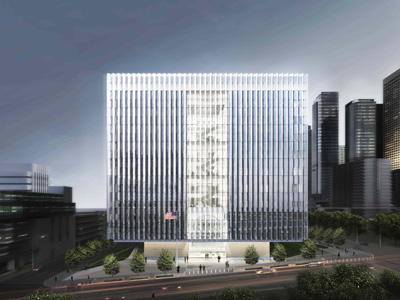 The concept of “floating” isn’t typical of courthouses.
The concept of “floating” isn’t typical of courthouses.
The norm for such facilities is to project authority while staying rooted in the foundations of justice. But the new United States Courthouse in Los Angeles, currently under construction, takes a different approach.
Developed in close collaboration with the Clark Construction Group, the design concept for the 633,000-sq.-ft facility, scheduled to open next July, is based on a novel idea of elevating the building above a large civic plaza by removing all vulnerable ground-level perimeter columns and supporting the entire structure on hardened-concrete shear wall cores. Since none of the perimeter columns extend to the ground level, the exterior loads are supported by a frame designed for redundancy around the entire building perimeter.
The open plaza area provides greater standoff (an additional 33 ft) from the neighboring streets and allows the cube to stand clear as an object. The core assemblies are designed to act as organizing elements for stairs and mechanical rooms and correspond directly to the organization of the floor layout. These cores provided excellent opportunities to support the building and provide lateral stiffness from the foundations through the entire height. The shear wall cores are linked with 16 steel buckling restrained braces (half with a capacity of 2,000 kips and half with 1,500 kips), manufactured by CoreBrace, to not only provide greater lateral load resistance but also provide greater long-term resiliency, given that the braces can be replaced if required following a major seismic event.
The core elements also provide support for a three-dimensional steel truss system at the roof level that supports the vertical loads beyond the cores. This allows the outer 33 ft of the building to be supported from the truss above and also lets the cubic massing appear as a singular form, hovering above the plaza. The trusses are designed with a innovative concept that is based on optimization principles. The final geometric form is similar to a bicycle wheel and resulted in material savings of over 15% when compared to the most efficient conventional trusses.
For more about the project, see the article “The Elevated Cube” in our current October issue (available now!).